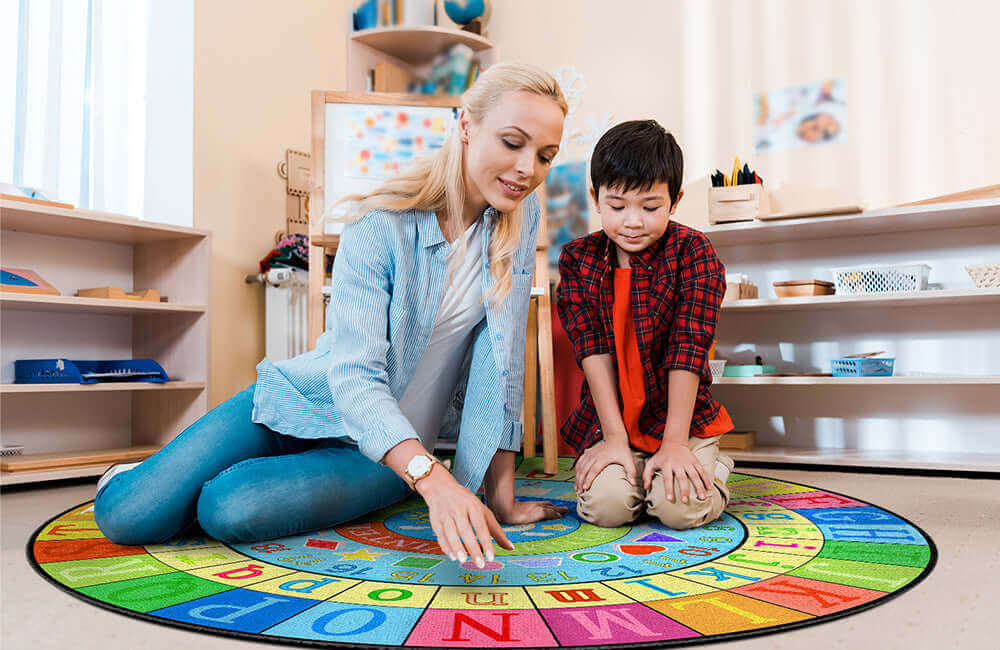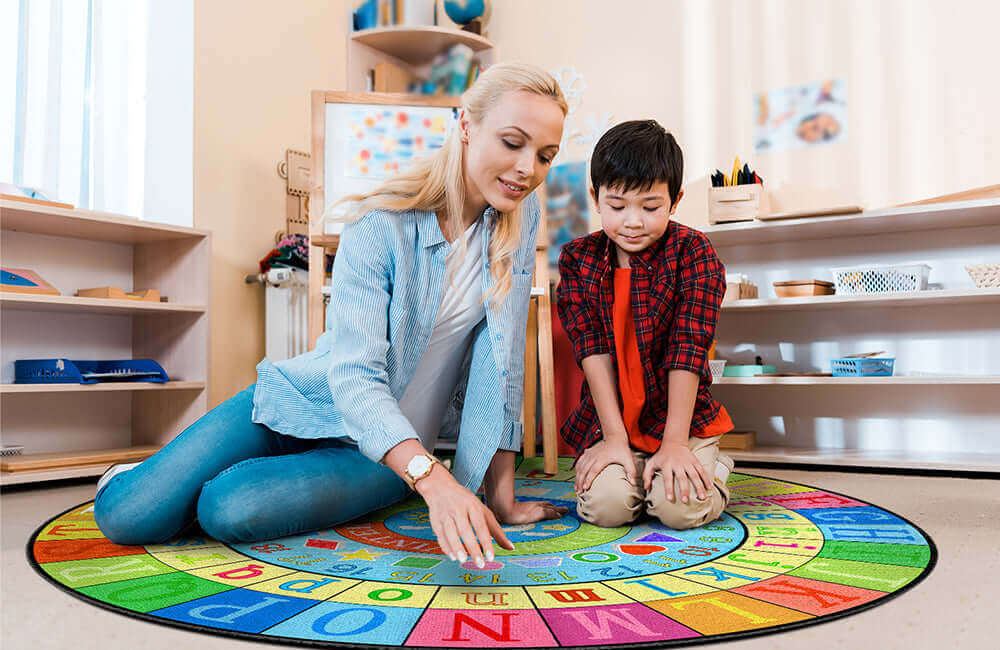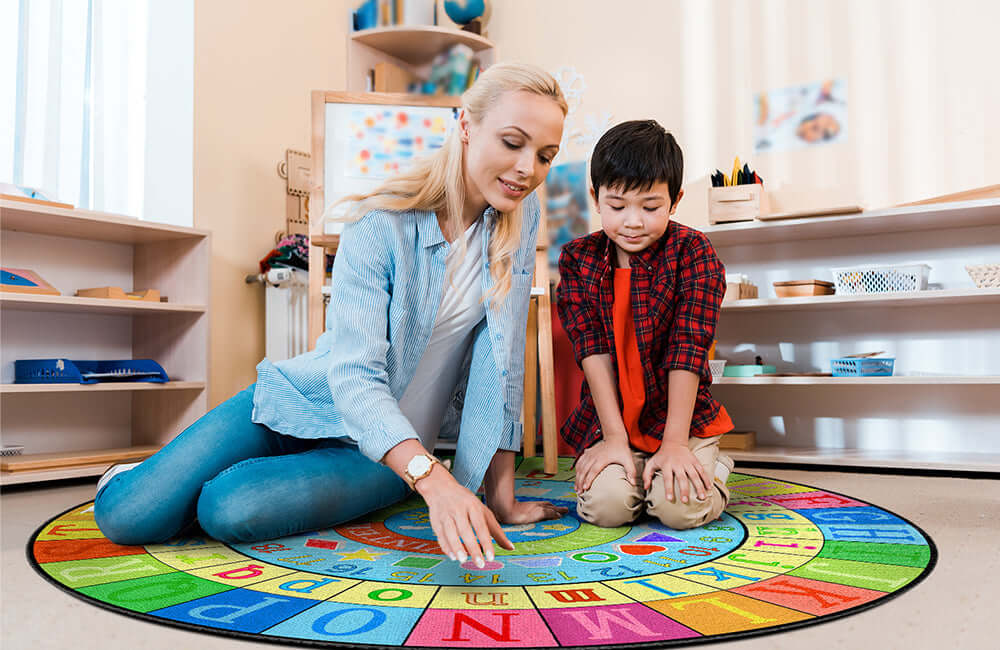The classroom floor—often the largest surface in any educational space—plays a crucial but frequently overlooked role in creating inclusive learning environments.
For students with sensory processing differences, autism spectrum disorders, ADHD, or anxiety, the texture, color, and placement of classroom carpets can significantly impact their ability to focus, regulate emotions, and engage with learning.
As educators increasingly recognize the importance of universal design for learning (UDL), sensory-friendly carpeting has emerged as a powerful tool for creating truly inclusive spaces that support diverse learners.
These thoughtfully selected floor coverings do more than just dampen noise; they create predictable boundaries, offer tactile comfort, reduce visual overstimulation, and provide safe spaces for self-regulation.
Sensory Processing in the Classroom
To select truly effective sensory-friendly carpets, it's helpful to understand how sensory processing impacts learning:
Sensory Processing Basics
Sensory processing refers to how the nervous system receives, organizes, and responds to sensory input. According to Wikipedia's article on sensory processing, differences in processing can manifest as:
- Hypersensitivity: Heightened sensitivity to stimuli, making ordinary sensations overwhelming
- Hyposensitivity: Reduced sensitivity, leading to sensory-seeking behaviors
- Sensory discrimination challenges: Difficulty distinguishing between similar sensory inputs
- Sensory-based motor disorders: Trouble with posture or movement in response to sensory information
Impact on Classroom Performance
Research highlighted in Edutopia's article on sensory-inclusive classrooms notes that sensory processing differences can significantly affect:
- Attention: Difficulty filtering irrelevant sensory input disrupts focus
- Emotional regulation: Sensory overload can trigger fight-flight-freeze responses
- Social engagement: Sensory discomfort can reduce capacity for social interaction
- Physical comfort: Bodily discomfort diverts cognitive resources from learning
For students with autism spectrum disorders, ADHD, anxiety disorders, and other neurodevelopmental conditions, the sensory environment can be the difference between engagement and shutdown.
For more in-depth information on how sensory processing affects student performance, visit our comprehensive guide on neurodivergent learning needs.
Key Features of Sensory-Friendly Carpets
When selecting carpets for sensory-inclusive classrooms, consider these essential characteristics:
Texture Considerations
- Low-pile options: Reduce tactile defensiveness for touch-sensitive students
- Consistent texture: Minimize unexpected tactile transitions
- Alternative textures: Designated areas with different textures for sensory-seeking students
- Smooth edges: Transition strips that prevent unexpected tactile changes between surfaces
Visual Elements
- Solid colors: Reduce visual overstimulation for visually sensitive students
- Muted tones: Calming blues, greens, and neutrals rather than bright primaries
- Limited patterns: Minimal or predictable patterns that don't create visual vibration
- Defined boundaries: Clear visual indicators of different classroom zones
Acoustic Properties
- Sound absorption: Higher density carpets to reduce noise levels
- Acoustic ratings: Look for carpets with high Noise Reduction Coefficients (NRC)
- Underlay quality: Enhanced padding for additional sound dampening
- Strategic placement: Sound-absorbing carpets in high-traffic or activity areas
Safety Factors
- Secure edges: Properly secured to prevent tripping
- Non-toxic materials: Low-VOC options for students with chemical sensitivities
- Hypoallergenic fibers: Reduced risk for students with allergies
- Antimicrobial treatments: Protection against mold and mildew for immune-sensitive students
As noted by Child Mind Institute's article on classroom accommodations, these seemingly small considerations can dramatically improve classroom accessibility for sensitive students.
Carpet Selection Guide by Sensory Need
Different sensory profiles benefit from specific carpet features:
For Tactile-Sensitive Students
Primary considerations: Texture consistency, touch-friendly surfaces Best carpet types:
- Low-pile, tightly woven commercial carpets
- Smooth, dense synthetic fibers
- Even, predictable surfaces without unexpected texture changes Colors and patterns: Solid colors or subtle patterns that don't compete for visual attention Additional features: Smooth transition strips between flooring types
For Tactile-Seeking Students
Primary considerations: Varied, interesting textures that provide sensory input Best carpet types:
- Designated areas with different textures (carpet tiles of varying heights), like those featured in our colorful classroom rugs section, can meet sensory-seeking needs.
- Carpet with intentional tactile elements
- Natural fiber options like wool or sisal in specific zones Colors and patterns: Can incorporate more visual interest Additional features: Textured transition strips between zones
For Visually Sensitive Students
Primary considerations: Reduced visual stimulation Best carpet types:
- Solid color carpets without patterns, like those in our simplicity rugs category, help reduce visual overstimulation.
- Muted, nature-inspired colors (blues, greens, earth tones)
- Non-reflective surfaces that don't create glare Colors and patterns: Avoid high-contrast patterns or bright colors Additional features: Consistent coloring throughout the classroom
For Auditory-Sensitive Students
Primary considerations: Sound absorption, noise reduction Best carpet types:
- High-density carpets with quality underlayment
- Thicker pile in specific areas where noise reduction is most needed
- Carpets with high Noise Reduction Coefficient ratings Colors and patterns: Less relevant than acoustic properties Additional features: Area rugs strategically placed in noisier centers can include our circle time rugs, designed for acoustic comfort during group activities.
According to Understood.org's guide on sensory processing, these tailored approaches help create environments where sensitive students can function at their best.
For specific product recommendations based on sensory needs, check out our resource guide on sensory-friendly classroom materials.
Strategic Placement for Maximum Benefit
Where and how you install sensory-friendly carpets significantly impacts their effectiveness:
Zoned Approach
Create intentional sensory zones with different carpet types:
- Calming zones: Soft, dense carpets in neutral colors like those in our pastel classroom rugs collection for regulation
- Active zones: Durable, easy-to-clean carpets for movement activities
- Collaborative zones: Moderate-texture carpets that balance sensory needs
- Independent work zones: Low-stimulation carpet areas for focused work
Transition Planning
Use carpeting to create clear transitions between different classroom activities:
- Visual boundaries: Different colored carpets to signal different expectations
- Texture transitions: Graduated changes between different flooring types
- Movement pathways: Carpet runners that direct traffic flow
- Activity markers: Special carpet spots that indicate specific positions or activities
Sensory Retreat Spaces
Designate specific carpeted areas for sensory regulation:
- Comfort corners: Soft carpeting with additional comfort elements, such as options found in our reading rugs collection.
- Reading nooks: Sound-dampening carpet with defined boundaries
- Quiet zones: Carpeted areas separated from high-activity centers
- Sensory break stations: Carpet areas with appropriate sensory tools
MindShift's article on inclusive classroom design emphasizes that these intentional spaces communicate to all students that diverse sensory needs are respected and valued.
Managing Competing Sensory Needs
One of the greatest challenges in sensory-inclusive design is accommodating different—sometimes opposing—sensory preferences. Here's how to address this challenge:
Balance Through Zoning
Create distinct areas for different sensory profiles:
- Sensory-muted zones: Minimal sensory input for hypersensitive students
- Sensory-rich zones: More texture and interactive elements for sensory-seekers
- Neutral buffer zones: Transitional spaces between different sensory areas
Clear Navigation Systems
Help students identify which areas match their sensory needs:
- Visual cues: Simple signage showing sensory qualities of each space
- Consistent mapping: Maintain consistent locations for different sensory zones
- Explicit teaching: Directly teach students about different available spaces
- Personal choice: Allow students autonomy in selecting appropriate zones
Flexible Implementation
Adapt to changing needs within your student community:
- Movable elements: Area rugs that can be rearranged as needed
- Sensory layer options: Carpet tiles that can be changed out seasonally
- Time-based adjustments: Different configurations for different activities
- Feedback loops: Regular check-ins with students about environmental fit
As Cult of Pedagogy's article on inclusive design points out, the goal isn't a one-size-fits-all solution but rather a thoughtful approach that honors diversity while creating manageable classroom systems.
For more strategies on balancing diverse sensory needs, see our guide on universal design for learning implementation.
Implementation Success Stories
Educators across grade levels report significant benefits from sensory-friendly carpet choices:
"After replacing our bright alphabet rug with a solid blue carpet, we saw immediate changes in Jason's participation during circle time.
He went from refusing to join us to becoming one of the most engaged participants. The visual calm of the new carpet made all the difference."
— Meredith T., Kindergarten Teacher
"We created three distinct carpet zones in our classroom—a plush navy area for quiet reading inspired by abstract classroom rugs, a low-pile gray section for group work, and a textured neutral zone for sensory breaks.
Students naturally gravitate to the spaces that work best for their current needs, and behavior incidents have decreased by almost 40%."
— Carlos R., 3rd Grade Teacher
"My middle school students helped design our classroom layout, including selecting carpet tiles for different areas.
Having ownership of the process and understanding the sensory purpose behind our choices has dramatically improved both compliance and comfort for my students with sensory processing challenges."
— Aisha J., 6th Grade Special Education Teacher
According to research featured in Teacher Magazine, these environmental adaptations often produce benefits far beyond the specifically targeted students, improving attention and comfort for the entire class.
Budget-Friendly Solutions
Sensory-friendly carpeting doesn't have to break your classroom budget:
Phased Implementation
Start with the highest-impact areas:
- Main gathering area: Focus first on your primary instruction space
- Designated calm zone: Create one fully sensory-friendly area
- Transition pathways: Use carpet runners for key traffic routes
- Target areas: Address specific locations where sensory issues commonly arise
Alternative Materials
Consider cost-effective alternatives with similar benefits:
- Interlocking foam tiles: Inexpensive, cleanable option for defined zones
- Remnant pieces: Source carpet remnants from local stores for small areas
- Washable rugs: Launderable options for specific activity centers
- DIY solutions: Repurpose materials like yoga mats for sensory spots
Funding Strategies
Explore multiple funding avenues:
- Special education allocations: Connect carpet needs to IEP accommodations
- DonorsChoose campaigns: Create targeted requests for specific classroom zones
- Parent-teacher organizations: Present sensory carpeting as an inclusion initiative
- Local business sponsorships: Partner with community organizations for support
For more budget-conscious classroom design ideas, visit our resource on affordable inclusive classrooms.
Maintenance Considerations
Sensory-friendly carpets require proper maintenance to remain effective:
Cleaning Protocols
Establish regular maintenance routines:
- Daily maintenance: Light vacuuming to remove surface debris
- Weekly deep cleaning: More thorough vacuuming with appropriate equipment
- Spot cleaning: Immediate attention to spills or accidents
- Seasonal deep cleaning: Professional cleaning during school breaks
Sensory-Friendly Cleaning Products
Choose cleaners that consider sensory sensitivities:
- Low-odor products: Avoid harsh chemical smells
- Residue-free solutions: Prevent texture changes from cleaning products
- Hypoallergenic options: Minimize potential allergic reactions
- Natural alternatives: Consider vinegar-based or other natural cleaners
Replacement Planning
Prepare for eventual replacement needs:
- Rotation systems: Move rugs periodically to distribute wear
- Quality investments: Higher initial costs often mean longer usability
- Replacement reserves: Budget for eventual replacement needs
- Documentation: Keep records of what works for future purchasing decisions
As noted in an article from Edweek on classroom maintenance, keeping carpets properly maintained isn't just about aesthetics—it's essential for maintaining their sensory benefits.
Conclusion
Classroom carpets, when thoughtfully selected with sensory needs in mind, become powerful tools for creating truly inclusive learning environments.
By considering texture, visual properties, sound absorption, and strategic placement, educators can transform ordinary floor coverings into foundational supports for diverse learners.
The beauty of sensory-friendly carpet choices is that they benefit all students while specifically supporting those with processing differences.
Quieter, visually calmer, and tactilely consistent environments—like those supported by our classroom rugs—reduce cognitive load and create more comfortable spaces where everyone can focus on learning rather than managing sensory discomfort.
As you consider your classroom's sensory landscape, remember that the floor beneath your students' feet is sending consistent messages throughout the school day.
With intentional carpet selection and placement, those messages can be ones of inclusion, comfort, and respect for diverse neurological experiences—creating truly accessible spaces where all students can thrive.




Leave a comment
This site is protected by hCaptcha and the hCaptcha Privacy Policy and Terms of Service apply.